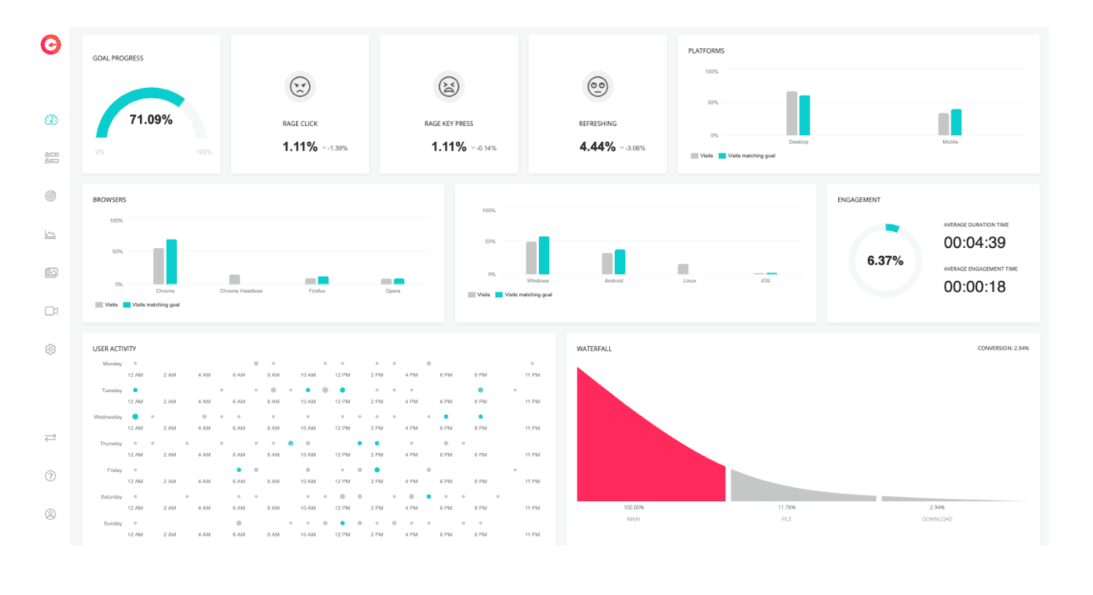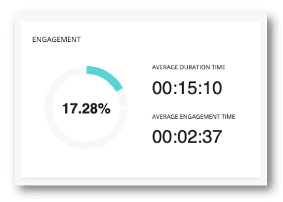Using Google Analytics for UX analysis
In terms of UX analysis, Google Analytics will fulfil the most basic data needs for most of its users. Google Analytics is the most used tool for monitoring online business performance, with over 29 million websites using it.
Google Analytics: features
Google Analytics allows you to track the performance of your website by measuring a number of parameters, such as interest, action, dwell time. Google Analytics is a software most suitable for beginners only getting started with user data analysis, with a number of useful features:
- Campaign measurement
- Goals tracking
- Audience reports
- Flow visualization
The more you progress, the more in need you will be for a tool with a higher accuracy and a larger number of features.

Using Google Analytics 360 for UX analysis
Google Analytics 360 is the most common choice the majority of Google Analytics users make when ‘upgrading’ their data analysis software. What does it deliver?
Google Analytics 360: features
Google Analytics 360 provides you with a larger capacity to gather your users’ data. Compared to the free version, Google Analytics 360 gives you access to:
- Unsampled Reports
- BigQuery Export
- Data Driven Attribution,
- A higher hit limit (20 billion monthly compared to 10 million)
A hit represents any interaction that generates data for Google Analytics. A higher hit limit ensures that you are not limited to viewing only a fraction of the data your users generate, especially when working with a high traffic site.
Even though GA 360 gives you lots of data to work with, quantitative data alone is not truly sufficient. If you are looking for a more tailored and precise UX analysis tool, finding a Google Analytics alternative should be the first point on your to-do list.
cux.io – the best Google Analytics and GA 360 alternative
The best thing about CUX as a Google Analytics and GA 360 alternative is that the software is both greatly advanced and simple to operate at the same time.
CUX equips their users with a set of advanced UX analysis tools, best for companies which realize the need of obtaining in-depth understanding of their users’ behavior, when interacting with the company’s website. As a Google Analytics and GA 360 alternative, CUX offers its users a plethora of features. With those, you will quickly understand your users’ pain points, spot missed opportunities, and optimize your website to increase your conversion rates.
CUX: features
CUX is a full-fledged UX analysis and automation software, focusing specifically on equipping you with easily-understandable insights on your website. Some of CUX’s most innovative features, when compared to Google Analytics, are:
Experience Metrics
CUX’s algorithm detects user behaviors that pose a threat to your conversions. Experience Metrics make it easy to spot your users’ frustration points, and transform them into quick wins. Eliminate broken links, inactive buttons and confusing design elements for a perfectly optimized customer journey.

Engagement recording
While Google only records the duration of the user’s visit on the site, CUX measures the engagement - the real activity time. Your user’s visit duration may be as long as an hour. But what does it matter if the best part of that hour was spent on a different tab? The metric that matters is exactly what amount of time the user spends actively interacting with your website, not for how long they leave it open among the 20 other tabs.

Visit recordings
While Google Analytics logs user behavior and other information of your site visitors through cookies and hits, CUX goes as far as to record the entire visit to your website. This allows for a much deeper insight into how the user interacted with the site during their stay. You can not only see where they clicked, but how many times they scrolled up and down, which part of the website caught their eye, how they moved their cursor, etc. But most importantly, you will see what frustrates them and drives them out of your site.
CUX and GA integration
You can, of course, use both cux.io and Google Analytics at the same time. With this you will be sure to have both the most important quantitative and qualitative data at your disposal.
By integrating your Google Analytics User-ID with cux.io, you can view the recording of a particular visit that caught your attention in Google Analytics. Now your users are no longer just numbers, you can see them for the complex individuals they are.

Google Analytics alternative - Wrapping up
Google Analytics is a great tool for individuals and businesses for whom quantitative analysis does the job. Unfortunately, it’s definitely not enough to step up your user experience game. If your goal is to develop a usable, well-optimized website, you need to obtain qualitative data about buyer intent, abandoned carts, customer journey, and user experience. This can only be achieved by using sophisticated UX analysis software. CUX is the best Google Analytics alternative for obtaining qualitative user data, finally allowing you to see the big and detailed picture of your users’ experience!